From the Editor guy: Enjoy Fabrizo’s 3rd installment presented exclusively to us for your enjoyment!
Third part of the Designer’s Notes for Less Than 60 Miles, currently in playtest here at Thin Red Line Games! As you maybe already know, the game covers the 1985 Warsaw Pact offensive in V Corps / Fulda area and takes its roots from SPI’s Central Front and NATO: Division Commander.
This part focuses on several decisions Commanders will have to take before and during an Operation, and on the factors influencing them. It will also give an idea of how the system works, without going down into excessive rules detail.
More info at the following links:
Official Game Page
Designer’s Notes, Part 1
Designer’s Notes, Part 2
Internal Playtest Session 13, Part 1
Internal Playtest Session 13, Part 2
Internal Playtest Session 15
Operations, or How Your Plan Will Fail
In preparing for battle I have always found that plans are useless, but planning is indispensable.
Dwight D. Eisenhower
As General Eisenhower suggested, any serious operation will need a plan bound to fail and some serious planning. Without planning, the result will be almost invariably chaos. Plans should not necessarily include detailed orders and movements for each unit until the ceasefire, but at least a generic framework must be defined before deploying the first unit.
To make things harder, time scale in Less Than 60 Miles makes more difficult for both sides to identify incoming problems and react in a timely manner, as a crisis could start almost unnoticed and silently reach the critical point over several turns. At that point, it will be probably too late to do anything.
In the following chapters, I’ll cover some standard operations and a possible plan to execute them. I’ll try to avoid any direct reference to the rules whenever possible, in order to help immersion and focus on the concepts, but most considerations and decisions described are the consequence of specific in-game rules. Players should find that the rules framework will make little difference on how a plan is conceived and executed.
Each chapter opens with the orders received by the higher command. Of course, during the game Players will cover that role too, so this part should be useful to understand additional elements taken into account when preparing the plan.
When considering time, please remember that the time line used in the examples has the following formats:
|
Date |
07/23/85 |
07/24/85 |
||||||
|
Civilian Time |
1500 |
1800 |
2100 |
0000 |
0300 |
0600 |
0900 |
etc… |
|
H Time |
H-15 |
H-12 |
H-9 |
H-6 |
H-3 |
H+0 |
H+3 |
etc… |
|
Event |
DEFCON 2 |
NATO Emergency Meeting |
NATO Mobilization Order |
DEFCON 1 |
WP offensive begins |
Covering Forces and Delay Action
One of the first things NATO will need is a Delay Action with its covering forces. In this example, one of the symbols of Cold War faces the task it’s been preparing for decades: slowing down Warsaw Pact’s First Echelon while US V Corps get ready to fight.
Easier said than done. Let’s see US V Corps orders to 11th Armored Cavalry Regiment:
SHAPE HQ confirms a major, coordinated Warsaw Pact offensive could be expected within the next 48 hours. Short of any radical change in the current situation, DEFCON 2 will be declared at 23071985 1500ZT.
Your Regiment will execute OPLAN 33001 immediately. More detailed orders follow:
-
11ACR will move to preplanned position on Line CONCORD at 24071985 0000ZT (H-6).
-
Squadrons will assume Screen Posture and execute delay actions, with Northern Flank linked to WG 5Pz Division and Southern Flank partially linked to US 8th Infantry Division Covering Forces.
-
Bridge mining has already been authorized, proceed at your discretion with available Combat Engineers.
-
2x Additional Engineer Co will be available until H+0 for deploying defensive works at your discretion.
-
Soviet 8th Guards Army, with 2 Divisions as First Echelon and 2 Divisions as Second Echelon, is expected to cross Inner German Border at 24071985 0600ZT (H+0).
-
Upon contact with enemy forward elements, Squadrons will conduct retrograde operations toward Line FARGO.
-
US 3rd Armored Division is expected to be in position on Line FARGO not before 24071985 1800ZT (H+12).
-
Upon reaching Line FARGO, Rgt will conduct a passage of lines through defending US 3AD units and proceed to Hungen Assembly Area to Rest, Refit and assume US V Corps operational reserve role.
-
Heavy enemy air strikes expected from 0600ZT (H+0) to 2100ZT (H+15).
-
Possible Integrated Battlefield since start of hostilities (in other words, chemical or nuclear attacks).
Assigned forces are:
-
1/11ACR, 3/11ACR Bns
-
4/11ACR Attack Helicopters Co
-
1-333 Lance Missile Bn
-
2-75 SP Artillery Bn
-
1-68/8ID ARM Bn, attached.
-
1x Combat Engineers Bn (1 Engineer Point)
-
1x A-10 Sqn Close Air Support (4 Air Points)
The main problem for covering forces is to avoid being decisively engaged by the enemy, as their Screen Posture is not particularly useful in case of heavy fighting. Moreover, if an enemy unit already opened a passage in the 10km range “screen area” subsequent units will not be delayed, and the covering action will be ineffective.
Covering forces must therefore try to keep the enemy at a safe distance and to disengage as soon as the enemy’s forward elements make contact, as even a successful defense will in the end reduce the possibilities of disengagement and survival.
Armored Cavalry and Recon are of course the most suited for this task, as their training focuses on maneuver combat and quick disengagement. Their success chances can be decisively increased in two ways:
-
Prevent engagement, by using available air and artillery assets to interdict the fastest approach routes to their defensive position.
-
Actively support disengagement with artillery and air assets, hampering the enemy’s attempts to keep contact.
The bottom line is: when executing a delay action, the main task for your available air and artillery is not supporting combat but slowing the enemy down and helping disengagement attempts.
Of course, the reverse is also true. Enemy will use its artillery to interdict retreat routes and to pin covering forces in place with barrage fire. Covering forces have a good survivability to barrage fire thanks to their dispersed formation, but if their exact location has been spotted by enemy recon elements a violent bombardment could be very dangerous anyway.
Enough pontification, let’s see the HQ plan on a map:
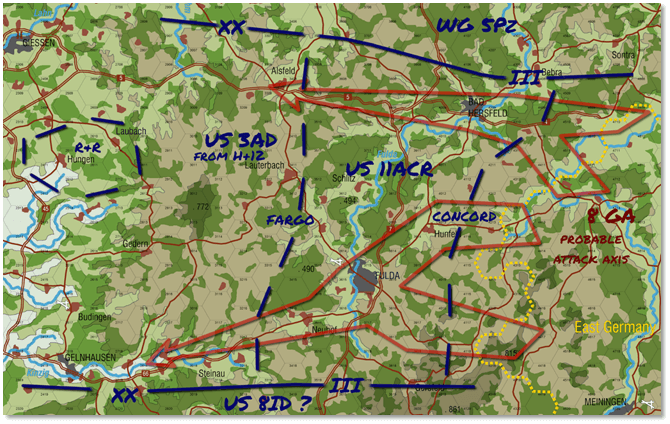
US V Corps Orders for 11th ACR
As we had a decent warning time, we will be able to assemble, give initial orders and move out before the outbreak of hostilities. This gives us a minimum of flexibility on the initial deployment of our combat forces. The obvious choice is along WP probable attack axis, as near as possible to Line CONCORD.
Our AH-1 Company will activate a predefined FARP about 15km North West of Fulda, as the coordinates of the military airfield are undoubtedly known to the Soviets, making it the perfect target for an air or missile strike. The selected FARP is already behind Line FARGO, so it should be covered by approaching US 3AD.
Missile Battalion, thanks to its long range, could be useful immediately. On the other hand, assigned SP Artillery Battalion will need several hours before being able to offer support, so I’ll not worry about it for now.
Our Combat Engineers Battalions already prepared several bridges for demolition. This is a definite advantage as the 6 hours required to mine an Autobahn bridge could be unavailable once the Soviets get rolling.
Combat Engineers also placed defensive works in the two most obvious choke points: Bad Hersfeld and Fulda. Not that we are going to make a stand, but additional defensive positions could force 8th Guards Army to pay a higher price to dislodge us.
Finally, we defined a CAS Area North of Fulda with some A-10 aircraft on call and positioned a Supply Hub in the rear areas for Rest&Refit.
When hostilities start, our A-10 air support will interdict the main roads used by the advancing Soviet columns. Together with the need to remove the Inner German Border defenses and to clear up the fleeing civilian traffic, this should severely hamper Warsaw Pact’s advance in the first few hours.
That said, our mere three battalions will do their best to slow down enemy advance as long as possible and retreat behind Line FARGO at any time after H+12. We must also keep in mind that according to HQ orders 11th ACR is NOT expendable, as after the delay action it will become US V Corps operational reserve.
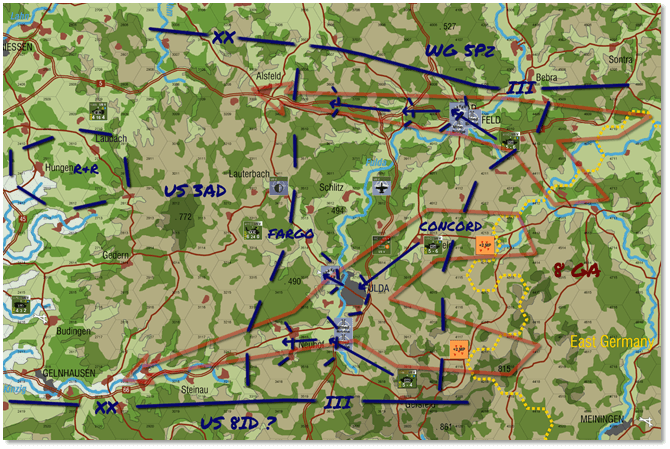
Operation Plan for 11th ACR
Move and Deploy for Area Defense
Another typical task for NATO is moving to an area and defend it. Here, a NATO Brigade is required to set up an Area Defense – that is, hold the assigned Area of Responsibility for as long as possible.
Let’s see the details of US V Corps HQ orders to 1st brigade, 3rd Armored Division:
SHAPE HQ notified all NATO countries that a major, coordinated Warsaw Pact offensive in Central Europe is expected to start at 24071985 0600ZT (H+0). A general mobilization order has been issued and DEFCON 2 has been declared by National Command Authority. Your orders follow.
-
1/3A Bde is assigned to defend Alsfeld area and deny enemy utilization of nearby roads until 25071985 1800ZT (H+36)
-
Bde will start assembling immediately and move out Ayers Kaserne at 24071985 0000ZT (H-6).
-
Upon reaching Alsfeld, Bde will establish a 20 Km frontage Area Defense centered on the town, with Northern Flank linked to West German 14/5Pz Bde and Southern flank partially covered by disengaging elements of 11ACR Rgt.
-
Soviet 79th Guards Tank Division is expected to advance along Autobahn 5 toward Alsfeld. with 11ACR covering forces slowing it down until 24071985 1800ZT (H+12).
-
Heavy enemy air strikes expected from 0600ZT (H+0) until 2100ZT (H+15).
-
Possible Integrated battlefield since start of hostilities (in other words, chemical or nuclear attacks).
-
Assigned Forces are:
-
-
2-36, 3-36 Mechanized Infantry Bns
-
2-32, 4-66 Armored Bns
-
2-3, 5-3 SP Artillery Bns
-
B/503 Attack Helicopter Co
-
1x Combat Engineers Bn (1 Engineer Point)
-
1x A-10 Sqn Close Air Support (3 Air Points)
Forming a solid defense line is a difficult task that requires good timing. You cannot simply move your forces toward the enemy, stop when contact is made and entrench, as changing posture while engaged is definitely a bad idea.
One possible solution is assigning some combat units as covering forces while the rest of the formation change to Defense Posture, but with a 20 km front line and only 4 available battalions we don’t have enough troops for that. We should try to have the Brigade deployed before contact is made with Soviet 79th Guards Tank Division.
As a first step, we need to know how to move to Alsfeld and how long it will take to get there. Road Posture is out of question as the enemy is expected to control the skies in the first hours, so we’ll have to stick to the slower Tactical Posture. Moreover, night movement from 0000ZT to 0600ZT will slow us down, and when hostilities begin at 0600ZT panicked civilians will turn main roads into horrible traffic jams. This brings up the following march table:
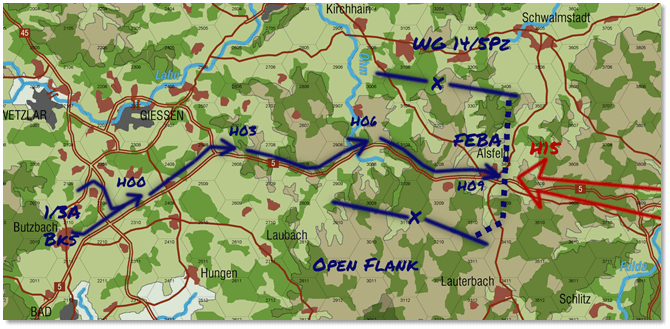
March Schedule for 1/3A Brigade
In the end, the whole brigade will be at Alsfeld around 1200ZT (H+6), in Tactical Posture. Forced march could speed up things a little, but on the other hand we didn’t consider enemy interferences such as interdiction strikes or missile bombardments. Not to mention chemical or nuclear warfare.
Now that we have an idea about when the brigade will arrive, it’s time to think about organizing it to defend the town. Ordering the Brigade to deploy in defense should take 9 hours, with 6 hours for planning by the involved HQs and 3 hours for deploying the maneuver units. Considering that our brigade will reach Alsfeld in Tactical March not before 1200ZT, this means that we will begin preparing and issuing a “Brigade Defend” order at 0900ZT, our units will begin deploying at 1500ZT and will be hopefully ready for enemy contact at 1800ZT.
A little tight. Moreover, time needed for preparing orders will increase considerably should an air strike hit a vital Command Post, leaving the brigade half-deployed with a Soviet tank Division charging toward its positions.
Too tight, we’ll need some to take some countermeasures beforehand. As there’s not much we can do about the marching time or the possibility of having a disrupted command chain, we’re back to using one of our armored battalion as covering force, in order to gain some additional hours should the necessity arise.
The cover battalion will be the first to move out from barracks and will double march to Alsfeld if needed. Once there, it will use Screen Posture to slow down Soviets during their final approach to the town. After the rest of the Brigade completes deployment, the Battalion will move to rear areas and switch to reserve in Tactical Posture.
The next thing to define is the detailed deployment of the Brigade in the Forward Edge of Battle Area (FEBA), better explained by a map:
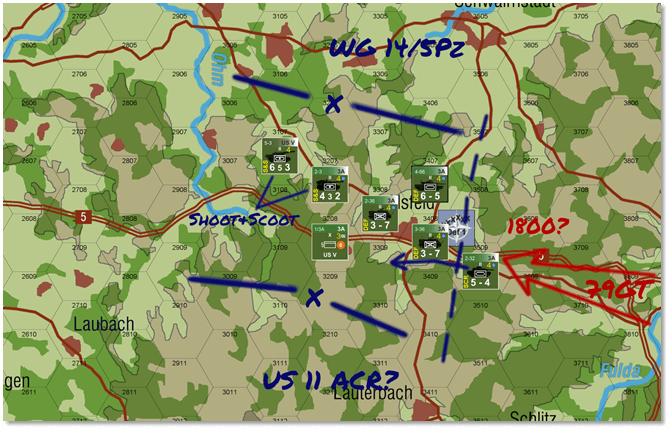
1/3A Brigade Area Defense
The two battalions in reserve could be used in three different ways:
-
Move to the front as soon as enemy pressure increases, allowing first line units to retreat, refit and take the role of reserves.
-
Block any enemy attempt to outflank our positions.
-
Should the front line suddenly collapse, stop the breakthrough and become the new main defense line.
The two SP Artillery Battalions will stay in Shoot&Scoot Posture as long as enemy air strikes are a concrete possibility, as any other Posture will turn them into sitting ducks; they will switch to Barrage once NATO Air Superiority has been (hopefully) established.
Attack Helicopter company will give additional support as needed, while our scarce Air Support will be used to interdict roads and help critical disengagements. Available CAS could increase as NATO fighters gradually gain control of the skies, but we’ll have to see what happens.
As a last thing, we’ll use our Combat Engineer Battalion to build defensive works in Alsfeld. Basic defensive works will take 6 hours, so the Brigade HQ must be in proximity of the town by 0600ZT in order to coordinate the task and have it finished by 1200ZT. HQs can move very fast, so this should not be a problem.
At a higher level, Corps HQ (yes, it’s you again) will have to take care of two important aspects: a nearby Supply Hub to ensure Resupply and Refit, and definition of a Close Air Support area in coordination with Air Forces.
Advance and Assault from March
In the opening phases of the conflict, Warsaw Pact will have to advance quickly against light enemy opposition. This example will describe the same overall situation of the previous ones, as seen from the other side of the coin.
Let’s look at 8th Guards Army orders to Soviet 79th Guards Tank Division:
Comrade Major General,
GSFG HQ confirmed Operation Sputnik will begin at 06:00 24.07.1985 as planned. As First Echelon of 8th Guards Combined Arms Army, your orders are:
-
Resolutely advance along Autobahn 4 and 5 on the Eisenach – Bad Hersfeld – Alsfeld – Bad Nauheim axis
-
Take control of the main crossroads along the advance axis, in order to ensure the safe passage of Second Echelon and follow-up supply columns.
-
Immediately engage NATO formations along the main advance axis, with no slowing down for assault preparation.
-
Take control of Bad Neuheim by 06:00 26.07.1985 (H+48).
-
Prepare to be relieved by 39th Guards Motorized Rifle Division and assume Army Operational Manoeuvre Group role.
Your Division will link to 1st Guards Tank Army to the North, and 27th Guards Motorized Rifle Division to the South. Rear areas security will be assured by Second Echelon forces.
Assigned support units are:
-
1/288, 2/288, 3/288 D-20 Artillery Bns
-
1/336, 2/336 Attack Helicopter Bns
-
171/11, 180/11 Missile Bns
-
296th Fighter Aviation Rgt, on call (8 Air Points)
-
3x Combat Engineers Bns (3 Engineer Points)
Initial enemy forces will be elements of US 11th Armored Cavalry Rgt, reinforced by US 1/3A Bde in 12 – 18 hours.
As could be expected, Warsaw Pact strategic plan requires a fast, blitzkrieg-like advance rate. Despite this understandable approach, Central Front’s time schedule for 79th Guards Tank Division sounds quite optimistic, particularly on point 4 – controlling Bad Neuheim by H+48. I seriously doubt the Division will be able to attack without any pause for 48 hours, unless NATO fails to materialize, or enemy resistance is significantly weaker than expected.
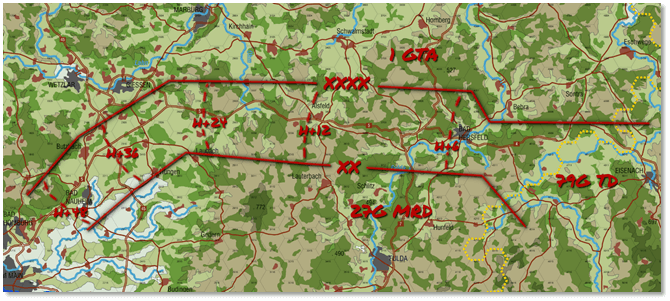
HQ Orders for 79th Guards Tank Division
In any case I’m not in the position to raise doubts. The High Command wants speed and 79th Guards Tank Division Commander must obey or face Martial Court. With these premises, our first decisions about Division’s march formation are already taken:
-
Our three Tank Regiments will advance in March Assault Posture, allowing to move fast and quickly assault weak defensive positions.
-
Division Self-Propelled Artillery will deploy in Close Support Posture, allowing fast movement and good bombardment firepower when needed.
-
Motorized Rifle Regiment will use Tactical Posture, giving some additional flexibility should the enemy try to disengage too quickly or counter-attack.
-
Recon battalion will use Recon Posture, allowing to reconnoiter enemy position before an assault at the cost of some losses on the recce units.
-
D-20 towed artillery battalions will follow in Tactical Posture and deploy in Barrage formation should we encounter tough resistance (This could take up to 6 hours).
The drawback of Assault from March and Close Support postures is the units will privilege speed over safety, making them vulnerable to enemy air strikes and artillery bombardment. If you need to move fast, that’s the price to pay.
I’m expecting to be able to keep these Orders for the first 24 hours. Should I need switching to Assault or Full Assault, it would mean the plan has failed as a similar reorganization requires at least 9 – 12 hours.
Having decided the march mode, we must now define how to deploy the Division at the Inner German Border. The most obvious choice would be taking autobahn 40 – 4 from Eisenach, but this route presents two problems:
-
The border bridge on Werra River has been probably mined by NATO and we cannot use Engineers to build ribbon or panel bridges across it, as this would require violating the border and making the imminent offensive obvious.
-
Autobahns will be cluttered by fleeing civilians, almost canceling the advantage of using main roads.
Therefore, we will cross the Inner German Border 20 – 30 Kms to the West, using secondary roads not depicted on the map and more close to Bad Hersfeld – our first objective. Now we have all the elements for drawing up a more realistic plan for 79th Guards Tank advance:
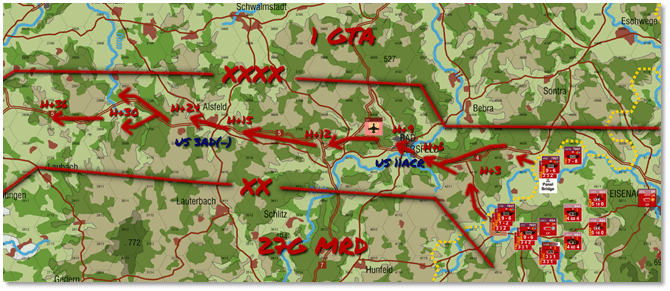
Operation Plan for 79th Guards Tank Division
Deployment is completed by:
-
A predefined CAS area allowing use of 296th Fighter Regiment Mig-23s to maximum effect within 20km from Bad Hersefeld. We will to redefine this with Front Aviation as our advance proceeds.
-
A Supply Hub ensuring us decent resupply at least for the first 20 kms of advance. Actually, resupply is always a question mark, particularly for artillery.
-
A Panel Bridge across the Werre, hidden from NATO observers, used as alternate supply route in case something should go wrong on the primary one.
Let’s see the expected problems:
-
As already said, during the first hours civilians will clutter the main roads, slowing down advance.
-
According to 8th Guards Army plan, we will not be replaced as First Echelon until H+48. This is by far more than the Division could stand, so we’ll have to keep attrition at a minimum in order to maintain an efficient assault force for as long as possible. This rules out forced marches and risky amphibious crossings.
-
We will need to move our Supply Hub forward as we advance, and to build a Panel Bridge at Bad Hersfeld to allow passage of supply trucks as NATO will probably blow the bridges.
-
Some Artillery Battalions could need to stop firing for short periods, in order to refit and resupply.
-
Missile Battalions will be used only after detecting with good approximation a high-value target, such as enemy HQs or Attack Helicopters FARP bases.
-
Air Support will be used initially to disrupt or block NATO disengagement attempts, and later as CAS to combat units.
-
At H+0: Division will have to wait for Combat Engineer to dismantle the security measures / minefields on East Germany side of the Inner German Border (estimated time one hour). This can be done only at the last minute to avoid announcing the imminent offensive.
-
At H+3: Possible first contact with US 11th ACR covering forces, slowing down advance.
-
At H+6: Bridges on Fulda River probably destroyed by NATO, so we’ll have to execute a (possibly) Opposed Prepared Crossing, costing us at least 1 hour of delay.
-
At H+9: City fight in Bad Hersfeld.
-
At H+15 – H+24: I expect to find at least one US Brigade from 3rd Armored Division waiting for us at Alsfeld. That, plus night hours will mean at least 9 hours to take control of the town.
-
At H+30 – H+36: After we’ve routed the US Brigade, Division could be able to advance until at least H+36 (Actually, I don’t believe this will happen. I wrote it only to please the Political Officer).
After H+36, Division will need to rest & refit for at least 12 hours. If HQ agrees, a different plan will be prepared having 79th Guards Tank as Second Echelon. Should HQ disagree, I’ll probably be shot for treason and therefore I’ll have no need for any further planning.
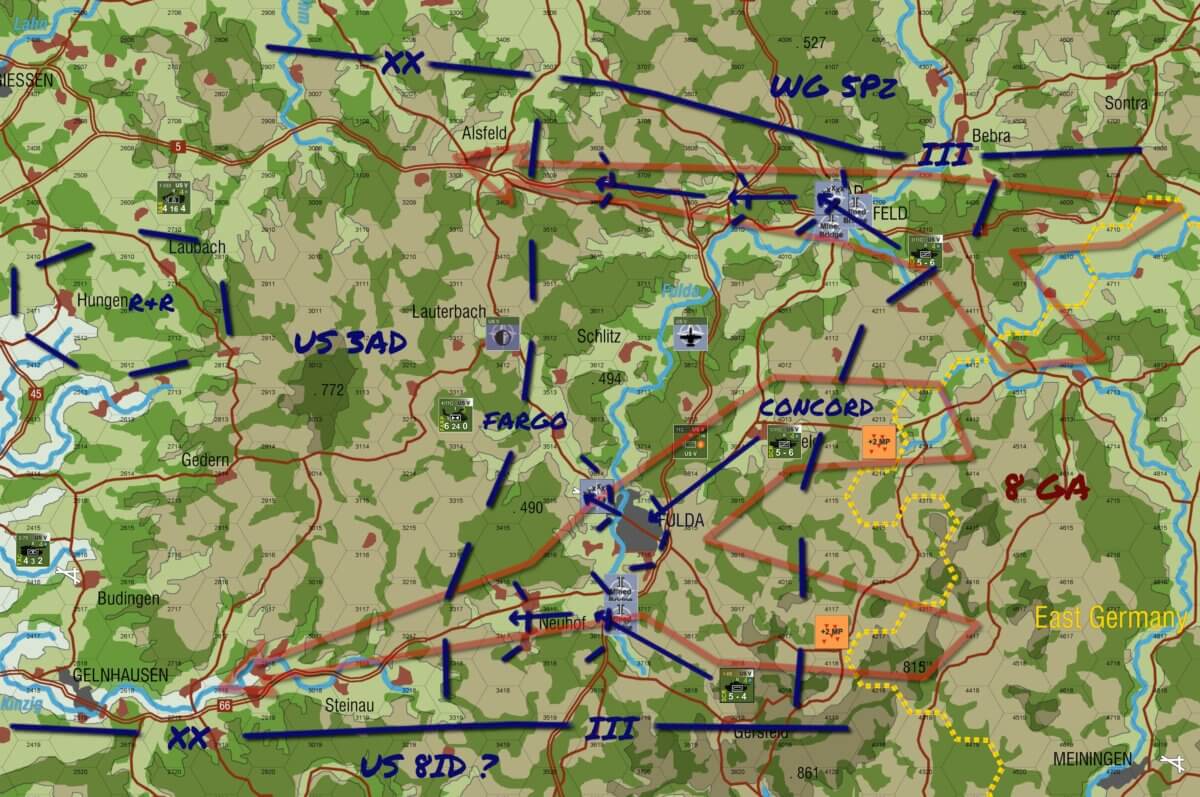
Comments are closed.